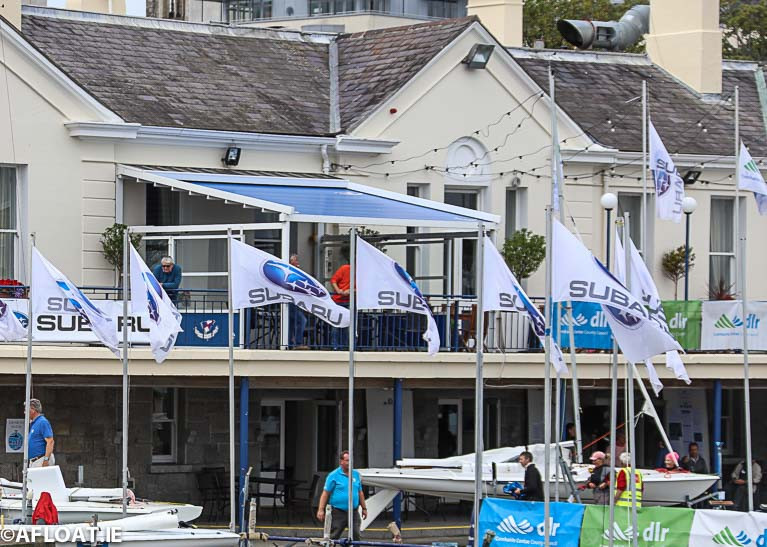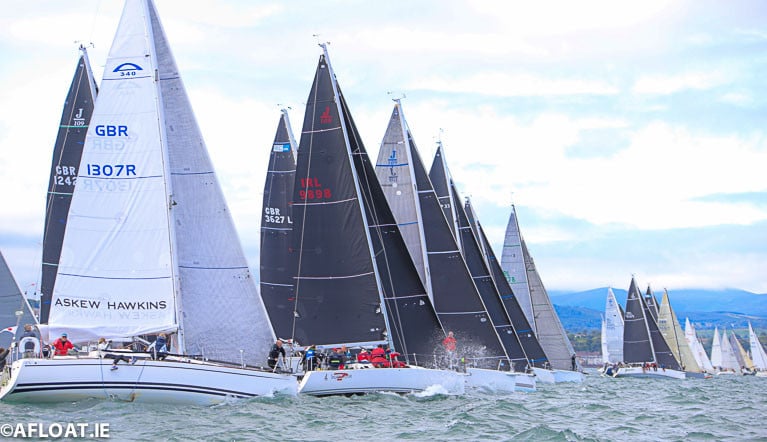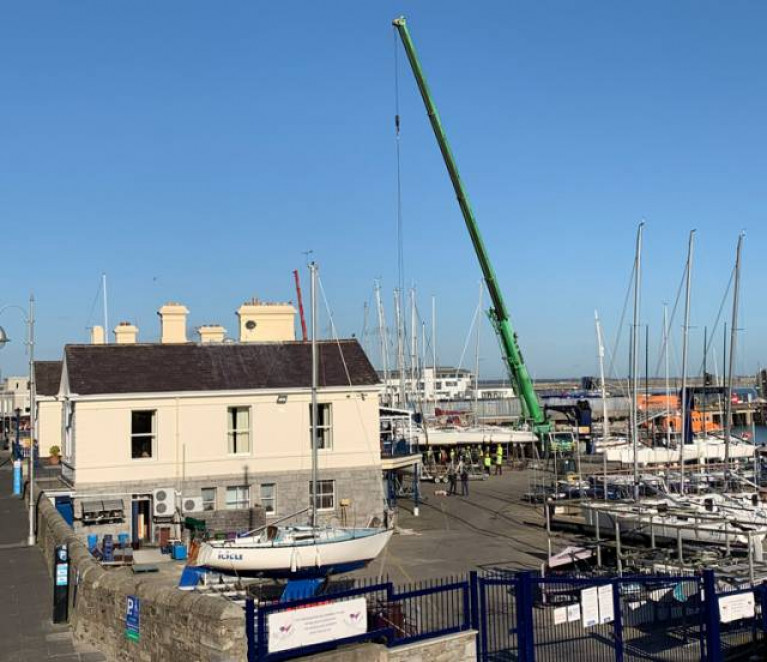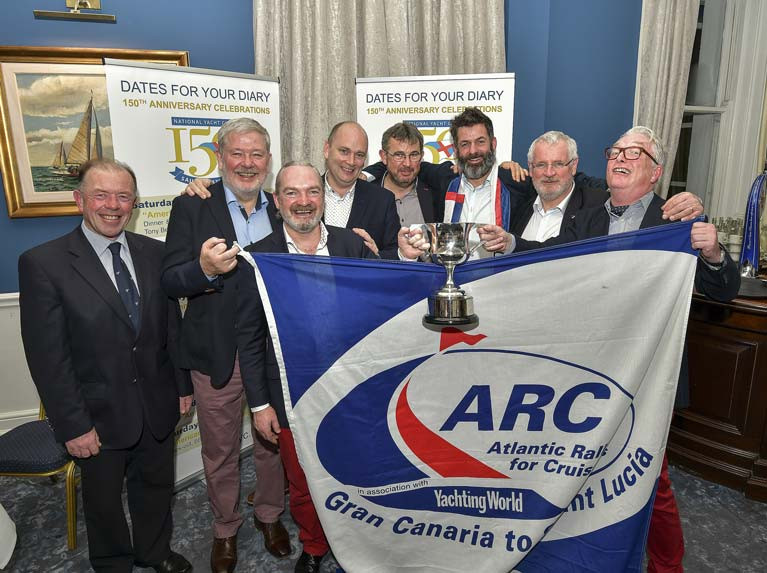Displaying items by tag: National Yacht Club
The generally accepted view of the 1950s in Ireland is of an economically grim period when everything - including the spirit of the inhabitants - withered in the face of a seemingly permanent financial recession, with desperate emigration the only solution for many young and sometimes not-so-young people. And in sailing, even though the early years of the decade had seemed a time of hope, with the new vision of the 1946-founded Irish Dinghy Racing Association still in the ascendant and people like Douglas Heard and Freddy Brownlee of Dun Laoghaire ordering the exciting new offshore racers Huff of Arklow and Flying Fox from the design board of the innovative Uffa Fox, the underlying trend was soon going downwards.
The nadir was reached in 1954-1956, when the American dollar was high against the pound that was then the Irish currency, and a connection to America saw the disposal for short-term profit of what was virtually an entire flotilla of some good Dun Laoghaire-based yachts to new American owners.
Baltimore-built 6-ton yawl Evora
Inevitably there was a typically Irish upside to this, as the decidedly individualistic businessman Dermot Barnes, having found a lucrative American buyer for his attractive John Kearney-designed 1936 Baltimore-built 6-ton yawl Evora, reckoned that the most economical way to comply with the purchase requirement for the boat be shipped to America was to get a keen young crew to sail her across the Atlantic.
 Dermot Barnes 30ft John B Kearney yawl Evora in Dun Laoghaire in 1954 shortly before she sailed for America under the command of Michael O’Herlihy of Hawaii Five-O fame. Photo: Dick Scott
Dermot Barnes 30ft John B Kearney yawl Evora in Dun Laoghaire in 1954 shortly before she sailed for America under the command of Michael O’Herlihy of Hawaii Five-O fame. Photo: Dick Scott
The delivery skipper was a determined guy called Michael “Styx” O’Herlihy, who had ambitions in showbusiness. Having reached the Promised Land with Evora, he promptly headed on west for Tinseltown, and became a huge success in television as a producer and director with Gunsmoke, Maverick, Star Trek, Hawaii Five-O, M*A*S*H, the A-Team and other top shows which one daren’t acclaim out loud for fear of age-recognition.
Meanwhile, Evora stayed on America’s East Coast for a while, but then someone with the west in their eyes took her away to sail round the world. The little Baltimore-built boat did well, as she got right across the Pacific to north Australia. But there the funds ran out, for in 1991 an Irish crew - voyaging round the world in some comfort in a Hallberg Rassy 46 – came upon her looking rather sorry for herself in Darwin.
It was a sad sight, yet it was also a reminder that back in the later 1950s, for most people all of Ireland was reckoned to be a sad sight. Yet when you consider some of the international businesses which were building on hard-earned success from a narrow Irish base during the 1950s, you can’t help but think this gloomy view of Ireland resulted from an unnecessarily negative groupthink which definitely wasn’t shared by everyone, yet was shared by enough for significant numbers to up-sticks and seek their fortune elsewhere.
Sparkman & Stephens-designed Gaia 36 Sarnia
As for those who stayed behind and made their way as best they could, we can see them as either dully unadventurous or quietly heroic. The quietly heroic were those who managed to build up businesses in that arid time, and it was as the photos by Michael Chester of last weekend’s lift-in at the National YC came up on the screen that there came a vivid reminder of one of the quiet heroes. For among the forty boats being heaved afloat in a remarkable day’s work, there was the 36ft Sparkman & Stephens-designed Gaia 36 Sarnia, now all of 54 years old, yet looking better than ever under the caring ownership of Michael Creedon.
 Class shows. Michael Creedon racing Sarnia.
Class shows. Michael Creedon racing Sarnia.
John Sisk
She was built as part of a series-production in Livorno in Italy by Cantieri Benello in 1966 for John G Sisk (1911-2001). He wasn’t quite the father of all the Sisks, for there were Sisks of significance in the building trade from the mid-1800s in Cork, where they built the majestic City Hall in 1930. But it was this John Sisk who, in the difficult business climate of the later 1930s at the age of just 26, decided to move the company’s main focus of operations in 1937 to Dublin, where he’d been in school at Clongowes Woods.
Gradually he built the business through the patient winning of major contracts for hospitals, cathedrals and bridges, such that by the late 1940s the company was the first in Ireland to sign major construction contracts for more than a million pounds apiece.
Yet it wasn’t all work. In Cork the family had been into boats and even when Dublin-resident they continued to holiday at Crosshaven. But while his father and grandfather had been content with commissioning new pleasure craft from local boatbuilders around Cork Harbour, in Dublin young John G Sisk became an investor in a yacht building enterprise called the Dalkey Shipyard Company, which despite its name was based at the head of the West Pier in Dun Laoghaire.
 A beacon of hope in wartime. The plans of the 38ft Cheerful Maid designed in 1943 by Robert Clark for John Sisk, as published in London in the Spring 1945 issue of The Yachtsman
A beacon of hope in wartime. The plans of the 38ft Cheerful Maid designed in 1943 by Robert Clark for John Sisk, as published in London in the Spring 1945 issue of The Yachtsman
 The classic profile of an offshore racer until the benefits of a separate vertical rudder were appreciated, as seen in the hull profile and accommodation of Cheerful Maid
The classic profile of an offshore racer until the benefits of a separate vertical rudder were appreciated, as seen in the hull profile and accommodation of Cheerful Maid
Robert Clark-designed sloop-rigged Cheerful Maid
Subsequently, it became the Dalkey Yacht Company and was best known for building a number of Folkboats long before the class became ubiquitous in Ireland. But in 1949 and again in 1954, it also built two substantial yachts for John G Sisk himself, the 38ft sloop-rigged Robert Clark-designed sloop-rigged Cheerful Maid in 1949, and the 41ft 6ins Knud Reimers-designed yawl Marian Maid in 1954.
The order for the design of Cheerful Maid was placed with Robert Clark in London in 1943, when there certainly was a world war going on. But John Sisk and Robert Clark seemed determined to maintain some semblance of a more normal life, so much so that the completed design appeared in the London-published Spring 1945 edition of the then-quarterly magazine The Yachtsman.
 Cheerful Maid ashore for the winter in Dun Laoghaire in 1951
Cheerful Maid ashore for the winter in Dun Laoghaire in 1951
This was all of six months before World War II ended in Europe, but such things were encouraged to a limited extent by the authorities as morale-boosting, for we can be quite sure that those fighting by sea and land would have devoured any information about the new boat as a harbinger of peacetime sailing.
 Despite the acute post-war shortages of material, the yacht-builders of Dun Laoghaire managed to build Cheerful Maid to the high standards required for her topside to be varnished
Despite the acute post-war shortages of material, the yacht-builders of Dun Laoghaire managed to build Cheerful Maid to the high standards required for her topside to be varnished
Knud Reimers-designed yawl Marian Maid
Cheerful Maid, when she finally appeared in Dublin Bay in 1949, was classic Robert Clark, a witch to windward but a bit of a handful downwind with that heavily-raked rudder. For his next boat Marian Maid. John Sisk went for a less-raked rudder with some flat along the bottom of the keel, but the main interest in this new Dun Laoghaire-built Maid was that she was designed by Knud Reimers of Sweden to the new International 8 Metre Cruiser-Racer Rule, which had been mainly devised by James McGruer of Scotland.
 John Sisk’s 8 Metre Cruiser-Racer Marian Maid was designed by Knud Reimers of Sweden, and built in Dun Laoghaire in 1954
John Sisk’s 8 Metre Cruiser-Racer Marian Maid was designed by Knud Reimers of Sweden, and built in Dun Laoghaire in 1954
Another Dublin Bay owner, Peter Odlum, had gone to McGruer for his boat to the new class, Namhara which was number 5, but John Sisk had a very European outlook, and getting a Swedish design was typical of his approach. However, although he sailed from the National Yacht Club in Dun Laoghaire, and continued to maintain his membership of both the Royal Cork and the Royal Munster in Cork, he was a busy man in work and somewhat reserved too, with a strong focus on family life.
Thus the energetic social and sporting scene of Dun Laoghaire sailing wasn’t really his thing, and his time afloat was largely a private affair, such that his son Hal observes that while he loved sailing, he wasn’t all that keen on racing despite having competitive racing boats, as he felt it sometimes brought out the worst in people.
Yet although he could be a prodigiously hard worker, he’d a company rule that all senior managers and specialists in the now-large Sisk organization should retire at the age of 60. So by the time the 1960s had arrived, he was in the count-down phase of handing over the reins to his oldest son George, with key roles in the company also being fulfilled by his other sons John and Hal, with the latter bringing a special marine expertise through spending his college years at the University of Delft in The Netherlands.
 John G Sisk (second left) with his sons John, George, and Hal on the occasion of his receiving the Lifetime Achievement Award of the Institute of Building. At the age of just 26 in 1937, he had moved the main focus of operations of the Sisk company from Cork to Dublin and had gone on to build it into one of the largest construction companies in the state with extensive international operations. But despite his exceptional work ethic, he retired at age 60, as he always said he would.
John G Sisk (second left) with his sons John, George, and Hal on the occasion of his receiving the Lifetime Achievement Award of the Institute of Building. At the age of just 26 in 1937, he had moved the main focus of operations of the Sisk company from Cork to Dublin and had gone on to build it into one of the largest construction companies in the state with extensive international operations. But despite his exceptional work ethic, he retired at age 60, as he always said he would.
Thus it was something of a joint family enterprise in selecting a new Sisk yacht for the mid-1960s, but the head of the family was ahead of the game in that he’d been in correspondence with designer Olin Stephens of New York, whose work he greatly admired.
Olin Stephens
The relationship between Sparkman & Stephens of New York and the offshore racing scene in Britain (and Ireland by extension) had not always been smooth. For although the very young Stephens brothers Olin and Rod and their indomitable father Roderick Senr had brought the all-beating Dorade to England in 1931 to win the Fastnet Race - which the brothers on their own then won again with Dorade in 1933 - no useful European design orders resulted from the campaign.
On the contrary, the result was less than pleasant. In 1933-34, Yachting World magazine ran a competition for a substantial yacht to the new 55ft rating rule of the Royal Ocean Racing Club, and the winner was a 72ft yawl designed by Olin Stephens. The detailed winning plans were published in the magazine in the best Yachting World style, and a Scottish whiskey magnate and notorious big game hunter after ivory (he proudly claimed to have killed more than a thousand elephants) promptly lifted the plans and took them to the noted steel trawler builders Hall, Russell of Aberdeen, and asked them could they build this boat in steel.
Trenchemer as she was to be called – named after William the Conqueror’s flagship of 1066 – was virtually finished, with her enormous spars well on their way to completion by McGruer’s on the Gareloch in their renowned spar shop, by the time Olin Stephens got to hear about it all. He felt badly done by, for apart from his rather shabby fee-avoidance treatment, he said that he could already think of several improvements he would have made to the design had he been involved in the building from the start.
 Olin Stephens at the height of his success in the 1960s. In 1934 while still building his career, he had felt rather bruised by the way he had been treated over the “abducted” designs for the 72ft Trenchemer
Olin Stephens at the height of his success in the 1960s. In 1934 while still building his career, he had felt rather bruised by the way he had been treated over the “abducted” designs for the 72ft Trenchemer
The big game hunter claimed that as the design had been published as the result of an open public competition, he felt it was in the public domain, for use by anyone. In time, some sort of settlement must have been reached, for when the new Trenchemer’s details were eventually published in Lloyd’s Register, Olin J Stephens was acknowledged as the designer. But the whole business left an unpleasant taste, which meant that when the Stephens brothers brought the new Stormy Weather to England for the 1935 Fastnet, they took quiet satisfaction from clearly beating all the newest British designs, although they probably had mixed feelings from trouncing Trenchemer too, but her navigation was all over the place as the compass adjusters had been unable to fully offset the effects of the big steel hull.
 The 54ft Zeearand was Sparkman & Stephens first proper European design commission and won owner Kees Bruynzeel of The Netherlands the 1937 Fastnet Race
The 54ft Zeearand was Sparkman & Stephens first proper European design commission and won owner Kees Bruynzeel of The Netherlands the 1937 Fastnet Race
After this third Fastnet win, they did finally get a proper design commission from the European side of the Atlantic, but it was from the Dutchman Kees Bruynzeel who was building a plywood manufacturing empire, yet found the time to commission and campaign a handsome new 54ft S&S design called Zeearand in the 1937 Fastnet race, and he duly won.
By this time Sparkman & Stephens were so busy with the expansion of their business in America and elsewhere that they didn’t need to expend unnecessary energy on cultivating a British clientele, and in Europe while they had a presence with a few boats in the Mediterranean, in northwest Europe they weren’t really centre stage again until 1959, when discerning Dutch owner Hendrik van Beuningen ordered the 35ft Hestia (she was S & S Design 1478, business was booming), and cut a mighty swathe through RORC racing and Cowes Week.
 Business is booming, The good-looking and very fast 35ft Hestia of 1959 was design number 1478, and put down a serious marker for the new range of S&S designs in Europe
Business is booming, The good-looking and very fast 35ft Hestia of 1959 was design number 1478, and put down a serious marker for the new range of S&S designs in Europe
 Hestia’s hull profile provided a very potent windward performance, but she was a handful downwind, and during the period 1962-65, Sparkman & Stephens developed a more manageable fin-and-skeg profile for their new production 36 footer
Hestia’s hull profile provided a very potent windward performance, but she was a handful downwind, and during the period 1962-65, Sparkman & Stephens developed a more manageable fin-and-skeg profile for their new production 36 footer
But by this time, yacht design was going into a fast-development stage, with the fin-and-skeg designs of Dick Carter coming successfully down the line in the wake of pioneering work by Ricus van der Stadt. Although the first S&S fin-and-skeg was the 43ft Deb (later Dai Mouse III, later Sunstone) in 1963, the skeg-hung rudder in this case looked like an afterthought rather than an integral part of the design.
Thus the traditional closed profile shape with the rudder now at an almost ludicrous angle was still the norm when the S&S-designed 43ft Clarion of Wight won the Fastnet Race for English owners Derek Boyer and Derek Miller in 1963.
So it was that, having first made their mark with the Fastnet win in 1931, after 32 years Sparkman & Stephens had become an overnight success in England. They were finally making their mark with the British offshore racing establishment, for although the difference between the RORC and Cruising Club of America rating rules had been seen as a barrier, ever since Bruynzeel’s Zeearand in 1937 the S&S team had shown they could create winners for European owners racing under the RORC rule.
 Hull profile of the 1963 Fastnet Race winner Clarion of Wight, “bringing overnight success to Sparkman & Stephens in Britain after only 32 years….” The main part of the race involved heavy windward work, so the downwind disadvantage of her much-raked rudder was not a significant problem
Hull profile of the 1963 Fastnet Race winner Clarion of Wight, “bringing overnight success to Sparkman & Stephens in Britain after only 32 years….” The main part of the race involved heavy windward work, so the downwind disadvantage of her much-raked rudder was not a significant problem
 Clarion of Wight racing for Ireland under Rory O’Hanlon’s ownership in the 1971 Fastnet Race, when she won the Philip Whitehead Cup. By this time – as is just visible - she had been changed to fin-and-skeg configuration
Clarion of Wight racing for Ireland under Rory O’Hanlon’s ownership in the 1971 Fastnet Race, when she won the Philip Whitehead Cup. By this time – as is just visible - she had been changed to fin-and-skeg configuration
Yet it wasn’t until the mid-1960s that this was finally accepted, and it was accepted for other rules as well. From Scotland, Peter Wilson ordered a new 8 Metre Cruiser-racer, to be called Nan of Gare, from Sparkman & Stephens. Fortunately, relations had already been smoothed with McGruer’s building the S&S designed Deb in 1963, for they were also to build Nan. But it may well be the Trenchemer bruising of 1934 still rankled, for having completed the design with Nan of Gare getting her first of many wins, Olin Stephens wrote a somewhat waspish critique of the International 8 Metre Cruiser/Racer Rule
For John Sisk in Dublin, this sudden rush to acquire a Sparkman & Stephens design threatened to de-rail his own developing relationship with Olin Stephens, but he needn’t have worried. The great designer wrote personal letters to Dublin revealing his concerns at making a proper change from an angled rudder on the back of the keel to a vertical and much more effective skeg-hung rudder which nevertheless looked as though it was an integral part of the whole concept, and he told of how they were working on a 36ft hull working on the basic canoe body which had proven such a success with Hestia, but with a new concept in the way the skeg-hung rudder blended with the whole.
 John G Sisk in retirement. As planned, he retired at 60, and had thirty years of retirement, “always interested in life and often rather amused by it”.
John G Sisk in retirement. As planned, he retired at 60, and had thirty years of retirement, “always interested in life and often rather amused by it”.
He further revealed that a new company in Finland was hoping to mould boats to this design, but meanwhile his long-established relations with Italy meant the design – which in Finland was to become known as the Swan 36 – was coming into production in Italy as the Gaia 36 at an earlier date, albeit with a different coachroof and a special highly-engineered foam sandwich construction, and might John Sisk be interested in one of these?
For John Sisk in conference in Dublin with his sons George, Hal and John, this was all music to their ears. Their engineering outlook much preferred the greater rigidity of the foam build, they liked the sound of the builders, they were all for Italy, and by 1966 they were owners of the new 36ft S&S instant classic Sarnia, a very handsome yacht in an attractive shade of emerald blue, and a brilliant all-round performer.
Sarnia has been one of the most cheering things in Irish sailing ever since. It is good to know that such boats are among us, and it as entirely appropriate that she should emerge in such style from among the crowd last Saturday at the National YC, John G Sisk’s Dun Laoghaire club. Michael Creedon deserves every credit for being such a devoted custodian of a true classic.
Suddenly, it’s summer in Dun Laoghaire Harbour. Oh for sure, we all well know that, meteorologically speaking, it seems to have been bright sunny summer in Dun Laoghaire town since at least Easter, and maybe earlier. But in the Harbour, it isn’t really officially summer until the anchorage within the curve of the East Pier – The Bight as it’s known – is well-filled with a colourful array of yachts and boats lying serenely to their moorings. And the first stage of that vital marker took shape on Saturday, with the annual lift-in - COVID-19 delayed for two months - at the National Yacht Club, with forty boats going afloat in a steady day’s work.
 Hibernation at the National YC. Thanks to the use of a long-jib crane, the boat-deck storage space is optimised for winter lay-up of members’ boats. But with the summer well upon us, the COVID-19 two-months delay meant they’d over-stayed their welcome. Photo: Brian McCullough
Hibernation at the National YC. Thanks to the use of a long-jib crane, the boat-deck storage space is optimised for winter lay-up of members’ boats. But with the summer well upon us, the COVID-19 two-months delay meant they’d over-stayed their welcome. Photo: Brian McCullough
Led by Commodore Martin McCarthy - who looked every inch The Gaffer with a decidedly rakish and stylishly white customised NYC hard hat - it was a communal members’ effort, focused around the professional skills of a William O’Brien crane whose driver seemed doubly-determined to prove the accuracy of firm’s motto: “O’Brien Can Shift It”.
The crane had an apparently endlessly-extending jib which would have disappeared into the cloud base, had there been one. But it was a day of searing sunny heat, despite which everyone kept their cool and worked in compliance with the Industrial Outdoor Covid Restrictions – in other words, Building Site Regulations.
 Dawn patrol for the first to be lifted-in. With forty boats to be splashed, it was an early start to a long day
Dawn patrol for the first to be lifted-in. With forty boats to be splashed, it was an early start to a long day
Having a long-jib crane is central to the operation, as its use maximises the boat-deck storage area. Instead of space-consuming trailers, the members’ boats can be neatly dropped from high above into and out of spaces only slightly bigger than their basic support cradles, in what is for all the world like a continuous “Beam me up, Scotty” procedure.
 “O’Brien Can Shift It” – an O’Brien long-jib extending crane enables boats to be extracted from their minimalist space-maximising berths in a “Beam me up, Scotty” operation. Photo: Afloat.ie/David O’Brien
“O’Brien Can Shift It” – an O’Brien long-jib extending crane enables boats to be extracted from their minimalist space-maximising berths in a “Beam me up, Scotty” operation. Photo: Afloat.ie/David O’Brien
Well, it wasn’t quite continuous, as the tidal times meant there was insufficient depth in the launching bay for two hours around the lunch-time low water. But although the clubhouse itself is shut, the kitchen is open, and the ubiquitous manager Tim O’Brien was on had to make sure that the creations of club chef Cormac Healy were rolling out for al fresco lunches in some welcome shade.
The it was back to work with the continued steady splashing-in of everything from the class of vintage Ruffian 23s (“We’re classics now, y’know”), right up to the flotilla of J/109s, including the Hall family’s distinctive dark blue Something Else, Dun Laoghaire’s senior boat of the marque.
 Dress code was high vis vest, hard hat and industrial gloves, but otherwise casual
Dress code was high vis vest, hard hat and industrial gloves, but otherwise casual
As late afternoon drew on, the boat-deck space emerged as newly-cleared, and it seemed enormous. There’ll be tidying up for a while and a bit of re-organisation, but by Thursday (June 4th) the space will be ready for dry-sailers and dinghies and the fleet of Flying Fifteens, finally released from their extended hibernation in storage in the Wicklow Mountains.
Meanwhile on Saturday after a day of mega-achievement, there was the return to the current reality, with the realisation that there was no question of everyone adjourning to the club bar for some very refreshing and well-earned pints. But useful alternative arrangements may have been in place on an individual basis, and anyway there was nothing to beat the refreshing feeling of a complex communal job very well done.
 Nearly there. A Shipman 28 goes aloft, with just four boats still to be launched in a long day’s work which saw forty boat go afloat. Photo: David OBrien/Afloat.ie
Nearly there. A Shipman 28 goes aloft, with just four boats still to be launched in a long day’s work which saw forty boat go afloat. Photo: David OBrien/Afloat.ie
Summer will continue to return officially to Dun Laoghaire Harbour in the coming days with the Royal Irish YC boat-deck open for use to dry-sailers and dinghies from Tuesday June 2nd onwards, while as mentioned just now, the National YC’s deck is in business from Thursday. Then on Saturday June 6th there are big crane lift-ins at the Royal St George YC and the Dun Laoghaire Motor YC, and on Sunday it’s the turn of the Coal Harbour Boatyard to make use of the crane which will have been at the DMYC on Saturday.
As to sailing, it is of course already available for those who can comply with some quite strict restrictions, and in theory some limited racing will be possible for these compliers. But now that the boats are getting afloat again, we can expect a greater focus on clarifying what is possible. To revert to Star Trek, it may not be racing as we know it, Jim, but it will be some sort of racing nevertheless.
 Almost the last in. The David Cheverton-designed wooden classic Carrick Witch finally gets gratefully afloat. The intense sunshine and heat of recent days has been very harsh on wooden boats still ashore
Almost the last in. The David Cheverton-designed wooden classic Carrick Witch finally gets gratefully afloat. The intense sunshine and heat of recent days has been very harsh on wooden boats still ashore
Additional photography by Michael Chester below





National Yacht Club Prepares for May 30th Lift-In
The National Yacht Club re-opened its platform at Dun Laoghaire Harbour yesterday, for the purpose of preparing boats for Lift in on Saturday 30th May.
The original annual lift-in date on April 11 was postponed due to COVID-19 restrictions.
The Government Roadmap Phase 2 starting on Monday, June 8th, and the NYC anticipate it will be possible for some sailing to take place thereafter.
The club is working with DBSC and the other clubs to shape a summer sailing program that is safe but 'exciting and fun', according to Commodore Martin McCarthy.
As Afloat reported previously, all four of Dun Laoghaire Harbour's Waterfront Clubs will combine to host a Solidarity Regatta on Friday 31st July & 1st August, all being well.
Meanwhile, the club's honorary member Annalise Murphy was back training yesterday after 55 days off the water, as Afloat reported here.
With the Government announcement last week of the phased plan to relax restrictions, sailing can begin preparing for a resumption of sailing activity in accordance with the phases of that plan. The National Yacht Club has now cancelled its special 150th-anniversary Regatta originally scheduled for the 10th to the 13th of June.
The NYC will be working with the other Dun Laoghaire waterfront clubs to put on the 'Dun Laoghaire Combined Clubs Solidarity Regatta 2020’ planned for 31st July to 3rd August if circumstances allow, and with a fallback Plan B date of September 5/6 also in the Irish Sailing and DBSC diaries.
The 2023 SB20 World Championships will be hosted in Ireland by the National Yacht Club in Dun Laoghaire Harbour, County Dublin.
The successful Irish bid for the event will see the World Championships return to Dublin Bay in September 2023, 15 years after the inaugural world championships were sailed at the NYC in 2008.
That event attracted 136 SB3s drawn from 13 countries and was won by Britain's Geoff Carveth, Roger Gilbert, Roz Allen & Sarah Allan.
More recently, Dun Laoghaire's Royal Irish Yacht Club hosted the successful SB20 European Championships in 2018 when a final race win for Royal St. George's Michael O'Connor, the 2017 SB20 Corinthian World Champion, allowed him to produce the goods again for Ireland by taking third overall.
The plan for 2023 is to achieve the largest ever number of nations attending an SB20 World Championships, according to SB20 Irish President John Malone.
Due to Covid-19 the SB20 Worlds in 2020 (Cascais), 2021 (Singapore) and the Europeans in 2021 (St Petersburg) have all been moved forward by one year, the updated Calendar is as follows:
SB20 World Championships Calendar
- 2021 Cascais, Portugal (29th of August to 3rd of September)
- 2022 Singapore
- 2022 St Petersburg, Russia (European Championships)
- 2023 Dun Laoghaire, Ireland (National Yacht Club, September)
- 2024 The Hague, Netherlands (June)
National Yacht Club Sailors Take eSailing League Challenge
The National Yacht Club has joined other yacht clubs across reland in launching its own members 'eSailing' League.
Series One of the NYC League will comprise five races every Thursday evening for the next four weeks using the ‘Virtual Regatta Inshore’ platform.
The Virtual Regatta platform allows you to race people from across the world and even get yourself an Irish Sailing ranking!
As regular Afloat readers will know, Aat the neighbouring Dun Laoghaire Harbour Royal Irish Yacht Club, Enda O'Coineen got the RIYC Virtual league underway on Saturday.
A racing tips video (get practising!) is here:
A new Dublin Bay regatta involving the whole Dun Laoghaire sailing waterfront has been announced for July 31st to August 3rd.
The 'Dun Laoghaire Combined Clubs Solidarity Regatta 2020' is an initiative of all five of Dun Laoghaire's yacht clubs as a response to the COVID-19 interrupted season.
"The event is a joint effort of the DMYC, RIYC, RStGYC, NYC and DBSC", according to Mark McGibney, the sailing manager of the Royal Irish Yacht Club.
We plan to run this regatta from Friday 31st July to the 3rd August.
In these uncertain times, the clubs have also decided to 'book' the weekend of the 5th/6th September as reserve dates if the August dates fall through.
More details as we have them.
Read also: 2020 Irish Sailing Fixtures (The Beyond COVID-19 Version)
The National Yacht Club has decided to reschedule the lift-in back to its ‘normal’ mid-April weekend (eg back by one week) to Saturday 11th April.
The lift-in had been brought forward by a week to Saturday 4th April as the 11th was during the Easter bank holiday weekend and the East Pier club were anticipating that some boat owners might be away.
However, as the weather has been very poor since Christmas and NYC says it thinks the additional time to prepare for the sailing season will be welcomed by owners.
The NYC says it doesn't think that many people will make travel arrangements over Easter or go on with previously made arrangements
The Irish Cruiser Racing (ICRA) National Championships return to Dublin Bay in 2021 it was confirmed at the weekend.
The National Yacht Club at Dun Laoghaire will host the three-day championships from May 28 to 30th, just a week before the East Pier Club also stages its biennial offshore 2021 Dun Laoghaire to Dingle race.
The announcement was made by ICRA Commodore Richard Colwell at last weekend's annual conference that attracted a turnout of 50 despite the storm warnings.
A fleet of up to 100 boats in four divisions is expected for the championships that last sailed in Dublin Bay in 2019 when hosted by the Royal St. George Yacht Club.
This year the championships are heading for Royal Cork Yacht Club as part of the line up for the Cork Harbour Club's 300th celebrations at Cork Week Regatta.
Meanwhile, Dun Laoghaire Dingle Race Chairman Adam Winkelmann has set the date for the next edition of the D2D as Wednesday 9th, June 2021.
Dun Laoghaire Harbour's National Yacht Club celebrated another year of great sailing by its members at their annual awards dinner last Saturday night.
The club, that celebrates its 150th birthday this year, has fourteen annual awards for outstanding sailing achievements by members awarded from nominations received from members of the Committee and Sailing Sub Committee.
The awards reflected a great horizon of sailing activity and administration in 2019.
Commodore Martin McCarthy awarded the "Commodore's Award" to Chris and Sandra Moore. The husband and wife team were rewarded for their dedicated and ongoing voluntary service in support of sailing.
Download the full NYC Awards booklet below. Prizegiving photos by Michael Chester
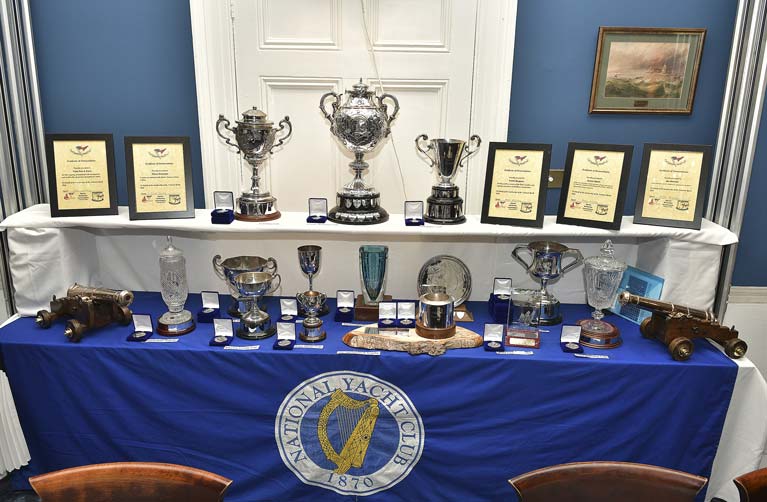 The Club has fourteen annual awards for outstanding sailing achievements
The Club has fourteen annual awards for outstanding sailing achievements
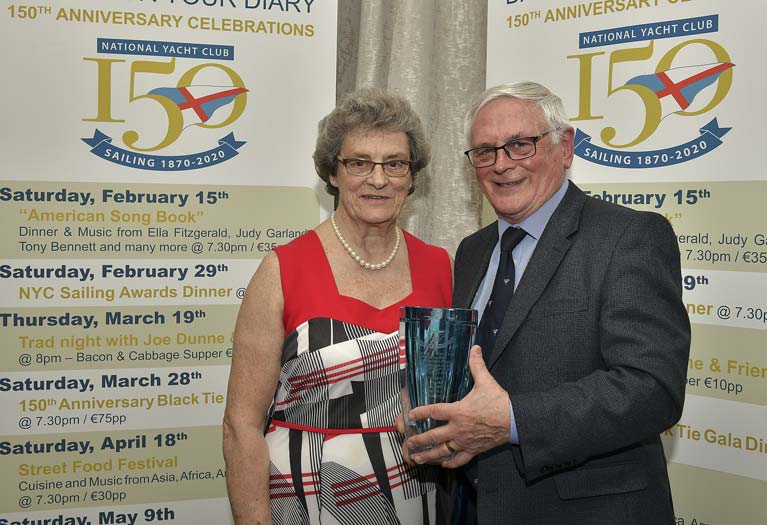 The Commodore’s award was presented to Chris and Sandra Moore. The award was made for their dedicated and ongoing voluntary service in support of sailing in the National Yacht Club and Dublin Bay Sailing Club over many years
The Commodore’s award was presented to Chris and Sandra Moore. The award was made for their dedicated and ongoing voluntary service in support of sailing in the National Yacht Club and Dublin Bay Sailing Club over many years
 John O’Gorman (left) receives The Boyne Regatta Cup. It is awarded to the member who achieved the best performance in Offshore racing of the year, he finished third in the Dun Laoghaire to Dingle race and was the best-placed National YC member
John O’Gorman (left) receives The Boyne Regatta Cup. It is awarded to the member who achieved the best performance in Offshore racing of the year, he finished third in the Dun Laoghaire to Dingle race and was the best-placed National YC member
 Clare Gorman receives The Winkleman trophy (2003) from her Mum & Dad Sarah and David. It is awarded to the cadet member who has the finest sailing achievements during the year
Clare Gorman receives The Winkleman trophy (2003) from her Mum & Dad Sarah and David. It is awarded to the cadet member who has the finest sailing achievements during the year
 Jack Roy receives The Paul Murphy Cup (2009) from Paul's widow Ruth. Jack has been awarded the Cup for his unmatched commitment in Race Management including as PRO every Thursday for DBSC and for the Subaru Flying Fifteen pre - worlds regatta and World Championships
Jack Roy receives The Paul Murphy Cup (2009) from Paul's widow Ruth. Jack has been awarded the Cup for his unmatched commitment in Race Management including as PRO every Thursday for DBSC and for the Subaru Flying Fifteen pre - worlds regatta and World Championships
 Chris Doorly and David O’Gorman receive The Edward Yacht Club Trophy (1919) from the Commadore Martin Mc Carthy is awarded to the member who achieves the best performance of the year in dinghies, Mermaids or Flying Fifteens
Chris Doorly and David O’Gorman receive The Edward Yacht Club Trophy (1919) from the Commadore Martin Mc Carthy is awarded to the member who achieves the best performance of the year in dinghies, Mermaids or Flying Fifteens
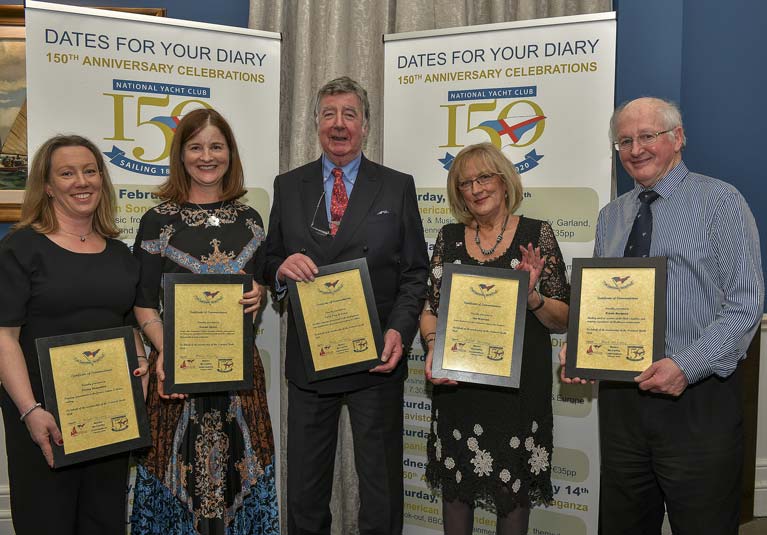 Commodore’s Commendation Fiona Staunton, Susan Spain, Tony Fox & Crew, Ida Kiernan and Frank Burgess for their contribution to the National Yacht Club in many areas
Commodore’s Commendation Fiona Staunton, Susan Spain, Tony Fox & Crew, Ida Kiernan and Frank Burgess for their contribution to the National Yacht Club in many areas
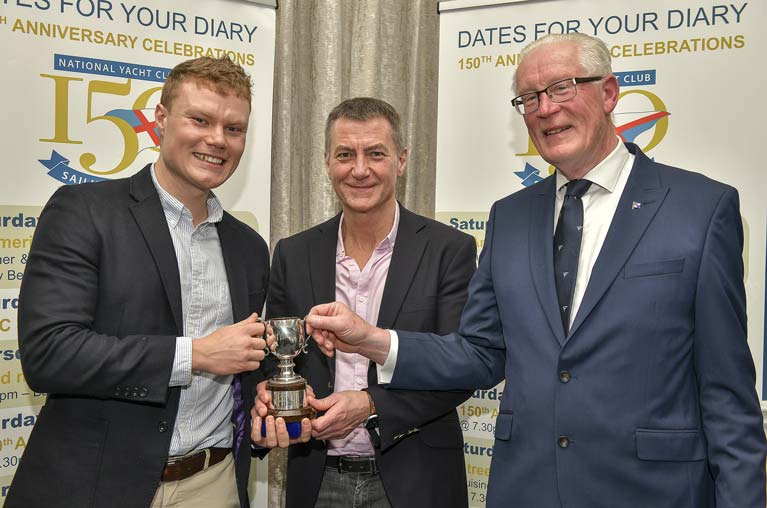 William Byrne, (Grandson of John Byrne) receives The John Byrne memorial trophy (1989) from his Father Rory and NYC Commodore Martin McCarthy. The Cup is awarded to the member who achieves the greatest contribution to sailing at the NYC during the year
William Byrne, (Grandson of John Byrne) receives The John Byrne memorial trophy (1989) from his Father Rory and NYC Commodore Martin McCarthy. The Cup is awarded to the member who achieves the greatest contribution to sailing at the NYC during the year
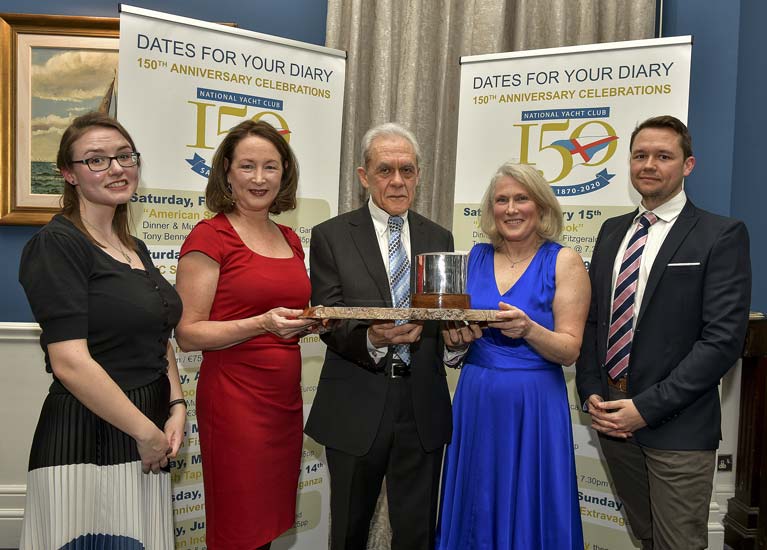 Helen Cooney and Rosemary O’Connell, receive The Sue McDonnell Trophy is awarded to the member who has contributed most to the advancement of women in sailing. Presenting the trophy is John, Sue's Husband.
Helen Cooney and Rosemary O’Connell, receive The Sue McDonnell Trophy is awarded to the member who has contributed most to the advancement of women in sailing. Presenting the trophy is John, Sue's Husband.
 The Martin Crotty Cup (2017) Tom Shanahan has been awarded the Martin Crotty Cup for his season as skipper of J109 Ruth campaigning in Dublin Bay and ISORA and finishing in fourth place in the Dun Laoghaire to Dingle race. Pictured are Ben and Tom Shanahan with Commodore Martin McCarthy
The Martin Crotty Cup (2017) Tom Shanahan has been awarded the Martin Crotty Cup for his season as skipper of J109 Ruth campaigning in Dublin Bay and ISORA and finishing in fourth place in the Dun Laoghaire to Dingle race. Pictured are Ben and Tom Shanahan with Commodore Martin McCarthy
 The Wild Geese Trophy was awarded to Ian Mathews (centre) for his outstanding and success in raising sponsorship for the Subaru Flying Fifteen World Championships while being based in Abu Dhabi
The Wild Geese Trophy was awarded to Ian Mathews (centre) for his outstanding and success in raising sponsorship for the Subaru Flying Fifteen World Championships while being based in Abu Dhabi
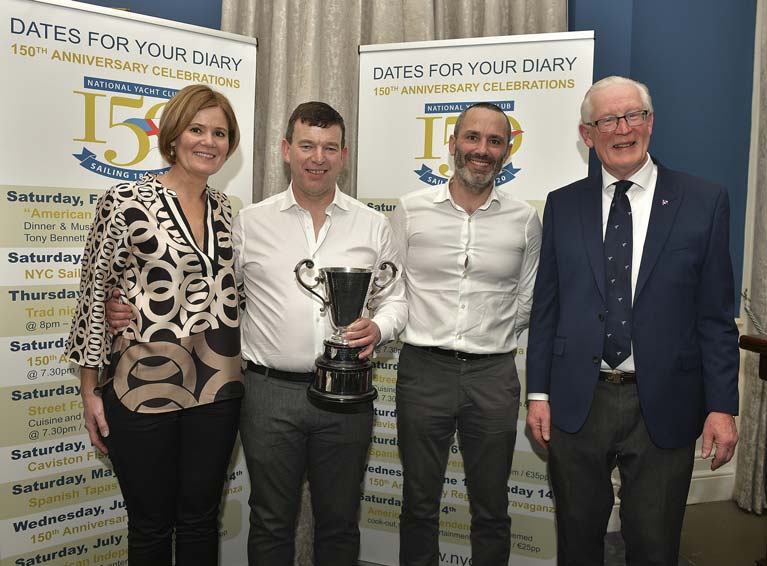 Brian Bourke receives The Muglins Cup (1949). Brian has been awarded the Mullins Cup for his family cruise to an isolated archipelago situated 40 miles west-northwest of North Uist in the North Atlantic Ocean
Brian Bourke receives The Muglins Cup (1949). Brian has been awarded the Mullins Cup for his family cruise to an isolated archipelago situated 40 miles west-northwest of North Uist in the North Atlantic Ocean
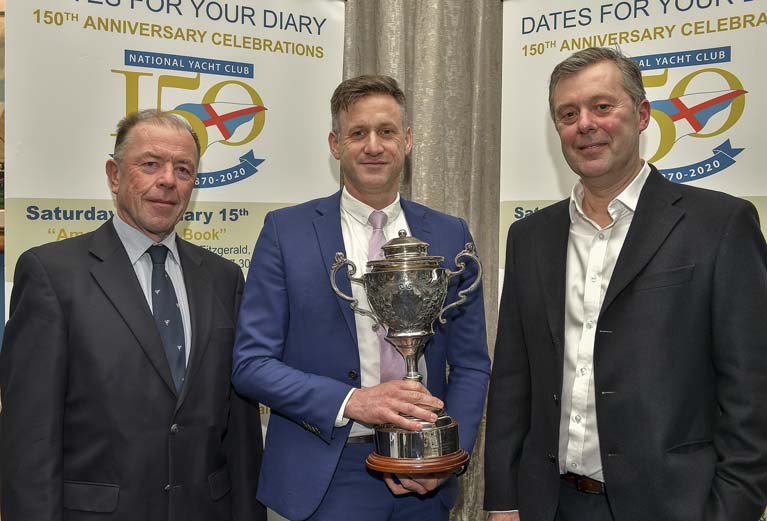 Noel Butler and Stephen Orman receive The O’Leary Cup. The trophy is awarded to the member who achieves the best performance of the year in One Designs. Noel and Stephen were rewarded for a “Fireball Grand Slam” in 2019.
Noel Butler and Stephen Orman receive The O’Leary Cup. The trophy is awarded to the member who achieves the best performance of the year in One Designs. Noel and Stephen were rewarded for a “Fireball Grand Slam” in 2019.





























